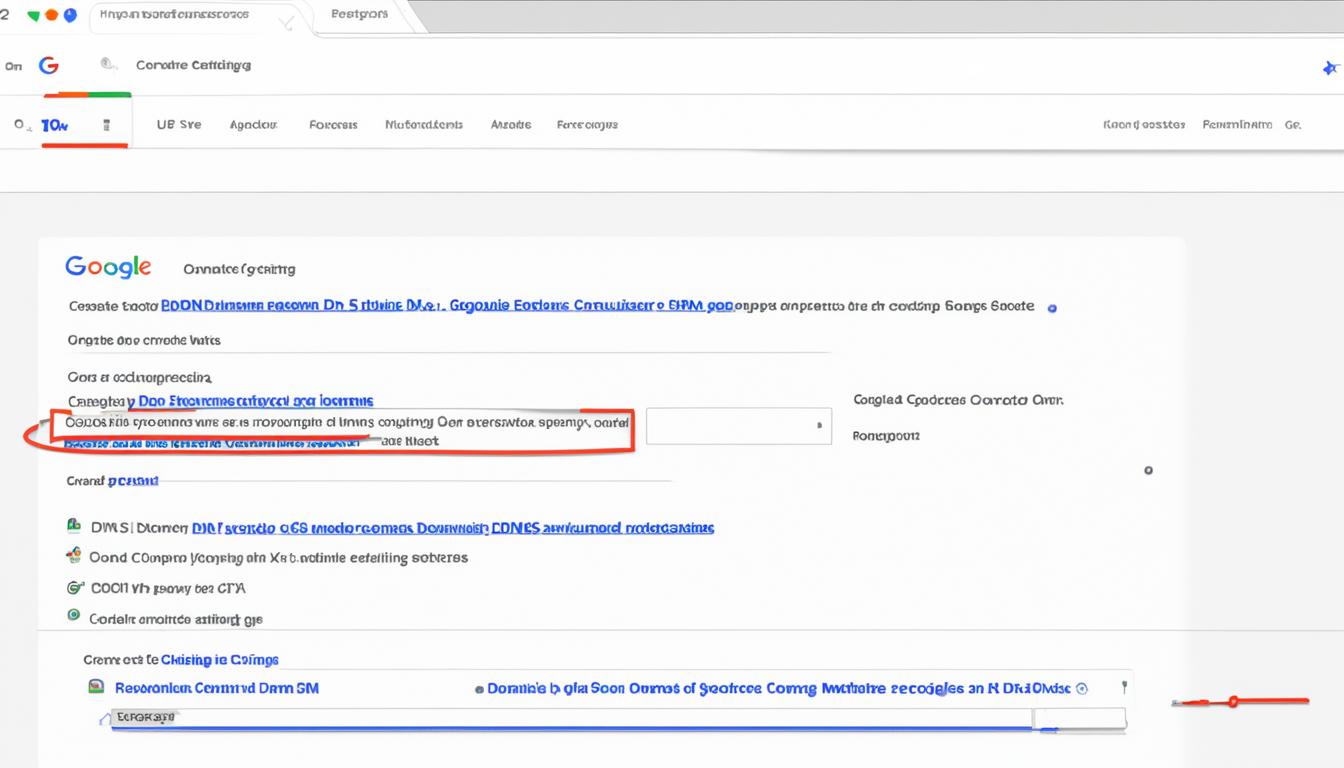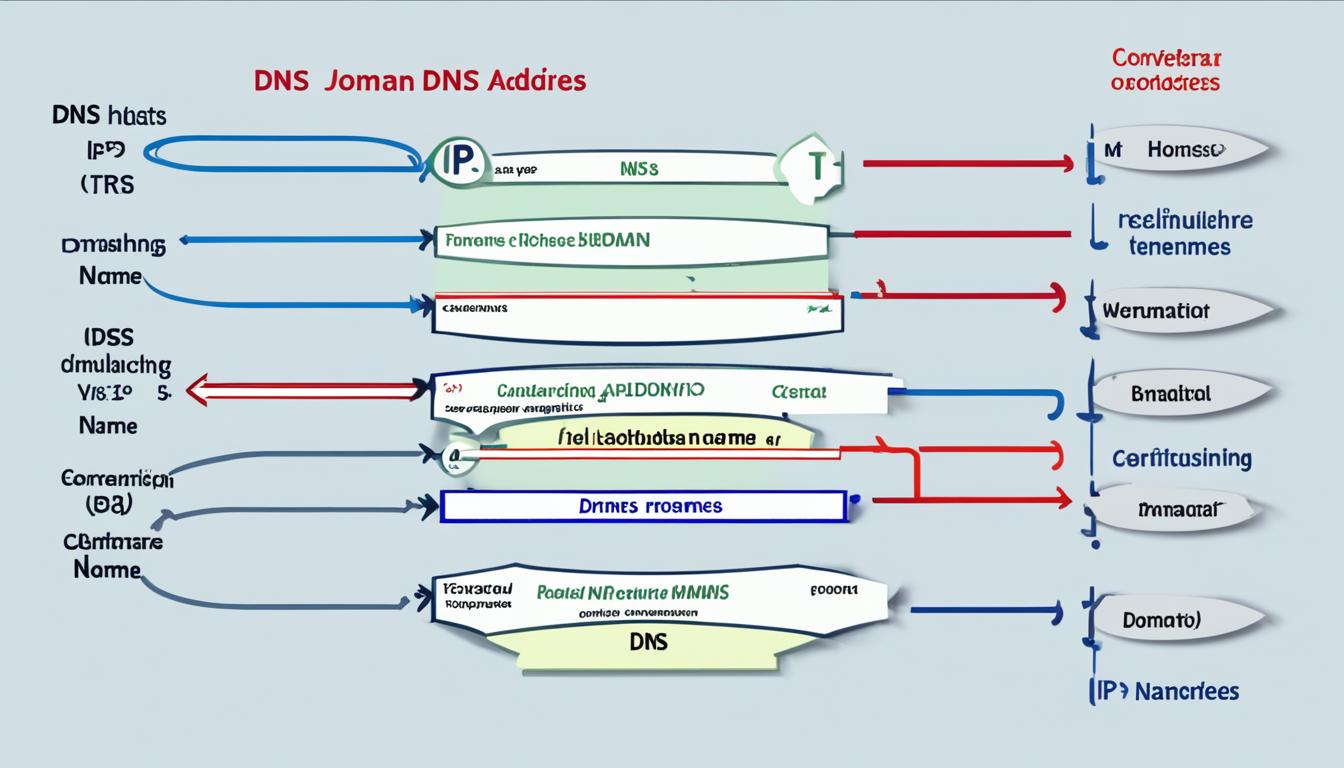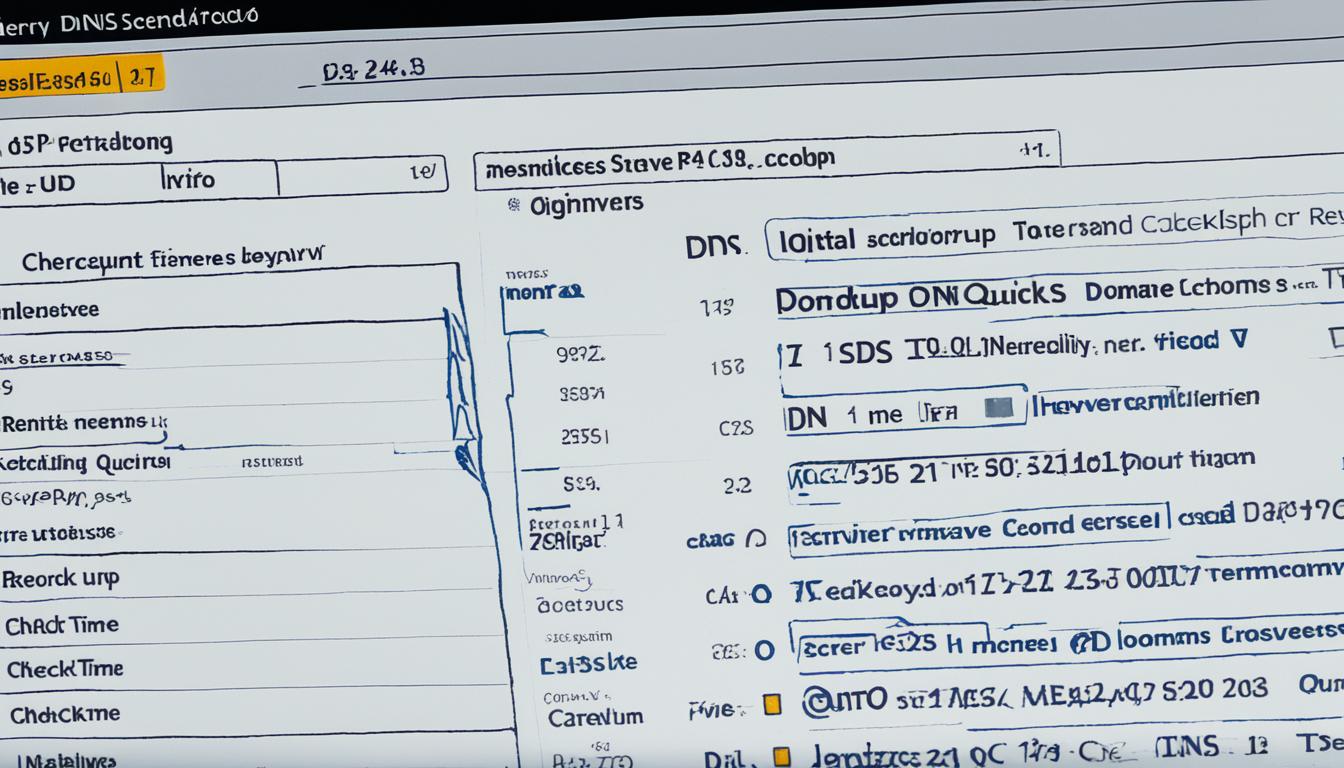DNS Records: Basic Guide to DNS Types
Did you know that there are over 350 million domain names registered worldwide? Each of these domain names is powered by a complex system called the Domain Name System (DNS), which translates human-readable domain names into IP addresses that computers can understand. Understanding DNS records is essential for managing your domain effectively and ensuring your website’s seamless functioning.
Key Takeaways:
- DNS records provide important information about a hostname or domain.
- The major DNS record types include A record, AAAA record, CNAME record, NS record, and MX record.
- The A record maps a domain to its current IPv4 address.
- The AAAA record points to an IPv6 address.
- The CNAME record creates an alias for a domain.
With this basic guide to DNS types, you’ll gain a clear understanding of how DNS records work and how they contribute to the smooth functioning of your website or online service. Let’s dive into each DNS record type and explore their unique functions and benefits.
A Record
The A record is a fundamental DNS record type that plays a crucial role in translating domain names into IP addresses. It acts as a bridge between the easily recognizable domain names we type into our web browsers and the underlying IP addresses that computers use to identify websites.
Through the A record, a domain name is mapped to its corresponding IP address, enabling efficient communication over the internet. This record is particularly important for IP address lookup, as it allows websites to be accessed by domain names instead of complex string of numbers.
The A record supports IPv4 addresses, which are based on 32-bit numerical values. These IP addresses are commonly used by websites and devices for network communication.
Furthermore, the A record serves another important purpose. It is employed in the domain name system-based blackhole list (DNSBL), which helps combat spam emails. By utilizing the A record, spam filters can block mail from known spam sources, enhancing email security and preventing unwanted messages from reaching your inbox.
How does the A record work?
When you type a domain name in your web browser’s address bar, it queries a DNS server to obtain the corresponding IP address. The DNS server then searches its records, including the A record, to find the IP address associated with that domain.
Once the web browser receives the IP address from the DNS server, it establishes a connection with the server hosting the website. The A record ensures a seamless translation process, allowing you to access websites easily using memorable domain names.
Benefits of the A record
The A record offers several benefits:
- Easy access to websites: Instead of remembering complex IP addresses, users can easily navigate the internet using domain names.
- Improved website management: By associating a domain name with its IP address, website owners can effectively manage their online presence.
- Efficient email filtering: The A record aids in preventing spam emails by allowing DNS-based blacklists to block mail from known spam sources.
Understanding the A record is essential for anyone involved in managing DNS configurations and ensuring the smooth functioning of websites and email systems.
AAAA Record
The AAAA record is an essential DNS record type that plays a crucial role in mapping domain names to IPv6 addresses. With the growth of the internet and the depletion of available IPv4 addresses, the AAAA record has gained increasing importance.
The AAAA record functions similarly to the A record but is designed specifically for IPv6 addresses. IPv6 is the next-generation internet protocol that offers a significantly larger address space compared to IPv4, allowing for a virtually unlimited number of unique addresses. This upgrade has become necessary due to the exhaustion of IPv4 addresses, making IPv6 essential for the continued expansion of the internet.
By using the AAAA record, websites and online services can effectively leverage the benefits of IPv6 addresses. These addresses consist of eight groups of four-digit hexadecimal numbers, separated by colons. In contrast, IPv4 addresses contain four groups of three-digit numbers, separated by periods.
To illustrate the importance of the AAAA record and the use of IPv6 addresses, let’s consider an example:
In the table below, you can see a comparison between IPv4 and IPv6 addresses:
| IPv4 Address | IPv6 Address |
|---|---|
| 192.0.2.1 | 2001:0db8:85a3:0000:0000:8a2e:0370:7334 |
| 203.0.113.0 | 2001:0db8:85a3:0000:0000:8a2e:0370:7335 |
| 198.51.100.45 | 2001:0db8:85a3:0000:0000:8a2e:0370:7336 |
As you can see, the IPv6 addresses are longer and contain more unique combinations, allowing for an almost limitless pool of available addresses. This is a significant advantage in a world where the number of internet-connected devices continues to grow rapidly.
By adopting the AAAA record and utilizing IPv6 addresses, organizations can future-proof their online presence and ensure seamless connectivity for users, regardless of the number of devices or the scale of their internet presence.
CNAME Record
The CNAME record, short for canonical name, is a crucial DNS record type that allows the creation of an alias for a domain. Instead of pointing to an IP address, the CNAME record points a domain name (an alias) to another domain. This record is commonly used for domain redirection and can be used to have multiple subdomains point to the same location.
By using a CNAME record, you can seamlessly redirect traffic from one domain to another without changing the IP address associated with the domain. This is particularly useful when you want to keep the original domain name intact but direct visitors to a different website or server.

It is important to note that while CNAME records provide flexibility and convenience, they should not be used for certain scenarios. Pointing a CNAME record to another CNAME can result in inefficiency and slower load speed. Additionally, CNAME records cannot coexist with other record types like A or AAAA records on the same hostname.
To illustrate the usage of CNAME records, here’s an example:
| Alias | Destination | Record Type |
|---|---|---|
| www | example.com | CNAME |
| blog | example.com | CNAME |
In the example above, the CNAME records for “www” and “blog” both point to the domain “example.com”. This allows visitors to access the website using either “www.example.com” or “blog.example.com” while still being directed to the same location.
Overall, CNAME records are a powerful tool for domain management, offering aliasing and redirection capabilities. By understanding how to effectively use CNAME records, you can optimize your website’s functionality and provide a seamless experience for your visitors.
NS Record
In the world of DNS, the NS record plays a vital role in connecting a domain name to the server where the website is hosted. NS, which stands for nameserver, serves as a pointer to the authoritative DNS server for a particular domain. This record helps internet applications, like web browsers, locate the IP address associated with a domain name.
Typically, multiple nameservers are specified for a domain, ensuring redundancy and reliability. In case one nameserver is unavailable, the others can still handle the DNS queries. This redundancy is essential for maintaining uninterrupted access to websites and online services.
When a user attempts to access a website using its domain name, the NS record provides the necessary information to direct the request towards the correct DNS server. This authoritative DNS server holds the most up-to-date and accurate information about the domain, including its associated IP address.
The NS record is often set up in conjunction with other DNS records, such as the A record or CNAME record, to ensure smooth navigation and accurate resolution of domain names.

Understanding the NS record is crucial for website owners and administrators, as it allows them to effectively manage their domain’s DNS infrastructure. By utilizing multiple authoritative DNS servers and properly configuring the NS record, they can ensure optimum performance, reliability, and availability for their websites.
| Benefits of NS Record |
|---|
| 1. Redundancy and fault tolerance: Multiple nameservers allow seamless DNS resolution even if one server becomes unreachable. |
| 2. Load balancing: Distributing DNS queries among multiple nameservers helps distribute the workload, enhancing overall performance. |
| 3. Flexibility: The NS record enables easy migration and changes to the authoritative DNS server without affecting the domain’s accessibility. |
| 4. Control: By configuring the NS record, website owners have complete control over the DNS infrastructure and can make changes as needed. |
Properly managing the NS record is essential for the smooth functioning and reliability of a domain’s DNS. By specifying the authoritative DNS server through the NS record, website owners can ensure that users can easily access their websites and online services with minimal disruption.
MX Record
The MX record, or mail exchange record, plays a crucial role in email routing for a domain. It ensures that emails sent to a specific domain are directed to the appropriate mail server. With MX records, you can have multiple mail exchange servers set up for a single domain, allowing for backup and redundancy in case one server becomes unavailable.
The MX record contains priority values that determine the order in which email servers are used. Servers with lower priority values have higher priority and are tried first. If a server with a lower priority is unreachable or unavailable, the next server with a higher priority value will be attempted.
Using MX records, you can route emails to dedicated mail servers designed specifically for managing and processing emails. This improves email management and enhances security for your domain.
Here’s an example of how MX records are set up:
| Priority | Mail Server |
|---|---|
| 10 | mailserver1.example.com |
| 20 | mailserver2.example.com |
In the example above, the lower priority value of 10 indicates that mailserver1.example.com is the primary mail server. If it is unavailable, emails will be routed to the mailserver2.example.com with a priority value of 20.
By configuring MX records effectively, you can ensure reliable email delivery and maintain uninterrupted communication for your domain.
Other DNS Record Types
In addition to the five major DNS record types mentioned earlier, there are several other record types with specific purposes. These lesser-known record types can play a crucial role in enhancing DNS management and troubleshooting. Let’s take a closer look at each of them:
The SOA record (start of authority) is used to store administrative information about a domain. It includes details such as the primary nameserver, contact email address, serial number, and more. Understanding the SOA record is vital for effectively managing and maintaining a domain.
The TXT record enables the storage of text values in the DNS. It can be used for various purposes, including email validation and ownership verification. By adding specific text values to the TXT record, you can enhance email deliverability and domain reputation.
The PTR record provides a domain name for reverse lookup. It is commonly used for reverse DNS lookups, where an IP address is resolved into a domain name. PTR records play a crucial role in ensuring accurate identification and verification of IP addresses.
The SRV record stores the IP address and port number for specific services. It allows you to associate a service with a domain, indicating the location where the service can be accessed. SRV records are commonly used for protocols like SIP, XMPP, and LDAP.
The CERT record is used to store public key certificates. It enables secure communication by associating cryptographic public keys with corresponding domain names. CERT records play a crucial role in ensuring the integrity and security of online transactions and data exchanges.
The DCHID record stores information related to the Dynamic Host Configuration Protocol (DHCP). It helps identify and authenticate DHCP clients and maintains the integrity of IP address assignment within a network.
Lastly, the DNAME record works similarly to the CNAME record but applies to all subdomains within a domain. It allows you to create an alias for all subdomains, simplifying DNS management and enabling seamless redirection of traffic.
By familiarizing yourself with these additional DNS record types, such as the SOA record, TXT record, PTR record, SRV record, CERT record, DCHID, and DNAME record, you can take your DNS management to the next level, ensuring efficient and reliable resolution of domain names.
FAQ
What are the major types of DNS records?
What is an A record and what is its purpose?
What is an AAAA record and what does it point to?
What is a CNAME record used for?
What does an NS record specify?
What is the purpose of an MX record?
Are there any other types of DNS records?
- How Strategic SEO Drove Growth for a CPAP E-commerce Brand - July 24, 2025
- Top 3 SEO Companies in Toronto: An Analytical Comparison - July 23, 2025
- SEO for Entry Door Services - April 24, 2025





















Post Comment
You must be logged in to post a comment.